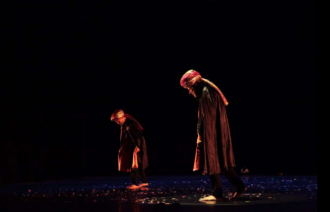“Are you enjoying your little trip down memory lane?” Joe Goode asked the audience at the YBCA Theater. They were, but he probably was not — the choreographer is loath to revisit old works.
But for the Joe Goode Performance Group’s 30th anniversary season, which opened on Thursday, June 22, he gamely went along for the ride. Goode performed in excerpts from four of his best-known dance-theater works and a world premiere, a mixed bill that offered an insightful overview of his pioneering artistry.
A former member of Margaret Jenkins Dance Company, Goode set out on his own in 1986. He considers spoken word, singing, acting, choreography, puppetry and video equal tools for transforming personal stories into what he calls “human-scale” performance. Created in collaboration with his longtime dancers, Goode’s works manifest his imagination and the richness of each artist’s identity — the antithesis of hyper-abstract, coldly cerebral postmodernism.
In “Grace” (2004), Andrew Ward and Felipe Barrueto-Cabello tossed Marit Brook-Kothlow back and forth as she wondered aloud about life choices. Patricia West opened the “The Rambler” (2011) excerpt with a monologue on feeling fenced in, flawlessly delivered while dancing on chairs; indeed, one of the company’s most salient strengths is that the multifaceted artists speak, sing and act as well as they move. It’s a potent and profoundly rare skill set.
Goode sets the example with his own fine diction, sweetly plaintive singing voice — there is a bit of Jimmie Dale Gilmore in his cowboy-yodel freedom song for “The Rambler” — and punch line timing. (He does a good striptease, too.)
Goode voiced the protagonist of “Wonderboy” (2009), a sensitive boy embodied in a Bunraku-style puppet designed by Basil Twist, and his choreography for Ward, Barrueto-Cabello, Melecio Estrella and James Graham is lyricism at its best.
Created in the depths of the AIDS crisis, “Remembering the Pool at the Best Western” (1991) is Goode’s memorial to lost friends. Original company member Liz Burritt reprised her role as an existential fairy godmother, Goode’s ironic companion on his trip down the rabbit hole of grief.
The excerpts serve as a primer and prelude to the new piece “Nobody Lives Here Now.” A fanciful fable on aging, loss and the human condition, it opens with Goode in a hilarious Norma Desmond moment and closes with his eulogy on youth and vitality. Between origin and destination, however, “Nobody” loses its way.
Seeking protection from mortal vulnerabilities, Ward becomes a Carnac-esque magician while Molly Katzman expounds on nonbinary gender identity. Burritt and Barrueto-Cabello are weary sidekick clowns, gesturing in unison while speaking monotone dialogue that bogs down in repetition. Outside of Katzman’s loose-limbed solo — danced with a nifty digital reader board on her head, spelling out meta-commentary — the choreography feels lethargic.
The trappings of “Nobody” are exquisite, and conjure a mystical miniature universe onstage: Thalea String Quartet playing Shostakovich, Mendelssohn, Debussy, Stravinsky and Adès; Jennifer Gonsalves’ evocative costumes; Jack Carpenter’s lighting and David Szlasa’s minimal props and projections. But for all “Nobody’s” presentational polish, its message remains murky.
Claudia Bauer is a Bay Area freelance writer.
